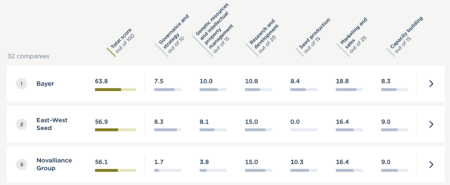- Seeds of resilience: the contribution of commons-based plant breeding and seed production to the social-ecological resilience of the agricultural sector. A seed production commons is good for agroecology and resilience. At least in the German-speaking vegetable sector. Yeah, but give them an inch…
- Crop Diversity Management System Commons: Revisiting the Role of Genebanks in the Network of Crop Diversity Actors. …and they’ll take a mile.
- Changing patterns in genebank acquisitions of crop genetic materials: An analysis of global policy drivers and potential consequences. Maybe it would be good if they took that mile.
- Seeds as natural capital. This is the mile we’re talking about. It’s worth fighting for.
- A Critical Review of the Current Global Ex Situ Conservation System for Plant Agrobiodiversity. II. Strengths and Weaknesses of the Current System and Recommendations for Its Improvement. It has become a really complicated mile.
- Uses and benefits of digital sequence information from plant genetic resources: Lessons learnt from botanical collections. And this makes it even more complicated.
- Impact of climate change on biodiversity and food security: a global perspective—a review article. Yeah, but look what happens if we don’t do something.
- Agrobiodiversity Index scores show agrobiodiversity is underutilized in national food systems. And we’re certainly not doing enough.
- Endangered Wild Crop Relatives of the Fertile Crescent. See what I mean?
- Crop diversity is associated with higher child diet diversity in Ethiopia, particularly among low-income households, but not in Vietnam. Sure, I know it’s complicated…
- Insights into the genetic basis of the pre-breeding potato clones developed at the Julius Kühn Institute for high and durable late blight resistance. …but just look what’s possible with a little effort…
- Spatiotemporal seed transfer zones as an efficient restoration strategy in response to climate change. …and a little thinking. Well, a lot of effort and thinking.
- Current Advancements and Limitations of Gene Editing in Orphan Crops. And on top of all that, we have this to look forward to.
- Inactivation of the germacrene A synthase genes by CRISPR/Cas9 eliminates the biosynthesis of sesquiterpene lactones in Cichorium intybus L. Well actually it’s already here.
- Living standards shape individual attitudes on genetically modified food around the world. Maybe if they were in a commons? Wait, isn’t this where we started?
- Waive CRISPR patents to meet food needs in low-income countries. It does look like it.
Nibbles: Ancient Levant, Guinness cherry, NBPGR, Maize in Africa
- More than milk and honey.
- A very large cherry.
- A very large genebank.
- Let them eat sorghum, Zambian president says.
- That’s not an option for the Hopi.
Smallholder access to seeds in Africa benchmarked
You’ll remember that the good people at Access to Seeds Index rate seed companies on how and to what extent they make their products available to smallholder farmer in developing countries. Today they launched the results for 32 companies working in Western and Central Africa. Here are the key findings (I’m quoting):
- Seed companies are active in almost all index countries across Sub-Saharan Africa and South and South-east Asia.
- Many companies are providing more diverse portfolios for vegetables and field crops but need to offer more pulses to help tackle malnutrition.
- Leading seed companies are offering extension services in more countries.
- Companies are still only concentrating their investments in infrastructure in a few countries.
But you want to know who did well in the rankings, right? Ok, here’s the Top 3.

Well done, Bayer, East-West and Novalliance.
Nibbles: Luxury brands, Food companies, TV and diets, Saving seeds, IUCN Green Status, 0 Hunger Pledge, Zizania
- Luxury brands discover biodiversity: “There is no champagne without grapes, no ready-to-wear without silk and cotton, no perfume without flowers…”
- What about global food and agriculture companies though? Let’s find out, shall we?
- TV can help where companies won’t.
- Of course, you can set up your own company, as these Tunisian women did.
- Imagine a company helping to move a species to “green status.” Imagine.
- They could sign the Zero Hunger Pledge for the Private Sector while they’re at it.
- But meanwhile, on Ojibwe land…
Nibbles: Genebanks in Brazil, Tunisia, Ghana, Ethiopia, Goan rice, Wheat adoption, Peruvian hot peppers & cacao, Amazonian fruits and nuts, Dates, Great Hedge of India, Conservation genetics presentation
- Safety duplicating a chickpea collection.
- Tunisia’s genebank in the news.
- Ghana’s genebank trying to save taro.
- Using a genebank to improve Elephant grass.
- On-farm conservation of rice in Goa.
- Molecular tools show that a couple of varieties account for about half the wheat acreage in Bangladesh and Nepal. Hope all the landraces are in genebanks, and safety duplicated.
- Celebrating Peruvian pepper diversity.
- Peru’s cacao diversity doesn’t need help, apparently.
- However, the Amazon’s wild-extracted fruits (including cacao and a wild relative) could be in trouble. Hope they’re in genebanks, just in case.
- How the date came to the US. Including its genebanks.
- India had a precursor of the Green Wall of Africa but nobody remembers it. Glad it wasn’t used as a genebank of sorts.
- Conservation genetics (i.e., most of the above) explained in 48 slides.